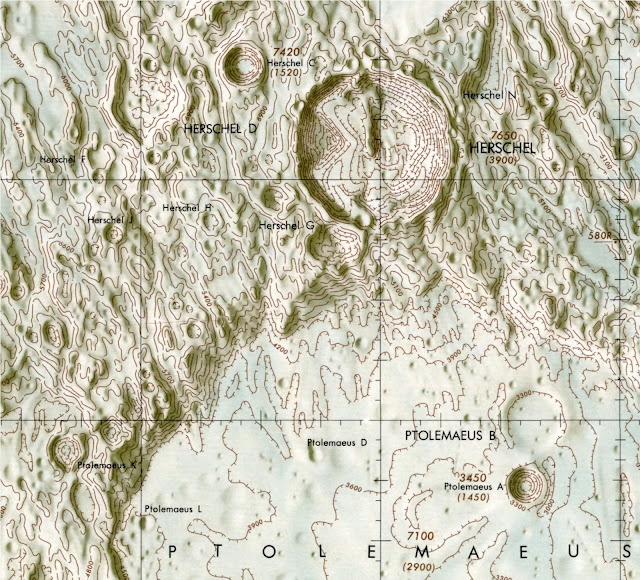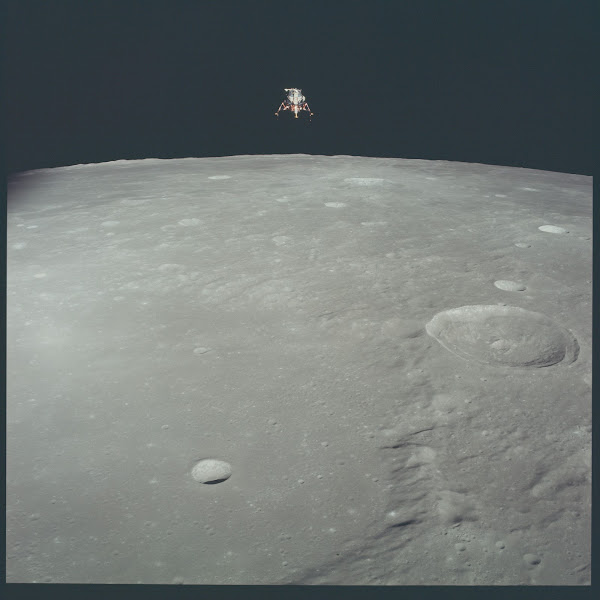Summary: Herschel Crater hosts eight satellites in the south central lunar near side, south-southwest of Sinus Medii, the point where Earth appears overhead.
Herschel Crater hosts eight satellites in the south central lunar near side, south-southwest of Sinus Medii (Bay of the Center), the small lunar mare that marks the intersection of the moon’s equator and prime meridian.
Herschel Crater is located in the lunar highlands that form Sinus Medii’s southern border. The highlands, known as terrae (singular: terra), roughen the landscape between Mare Tranquillitatis (Sea of Tranquility) and Mare Nectaris (Sea of Nectar) to the east and Mare Cognitum (Sea That Has Become Known) and Mare Nubium (Sea of Clouds) to the west.
The small lunar impact crater has a center latitude of minus 5.69 degrees south and a center longitude of minus 2.09 degrees west, according to the International Astronomical Union’s (IAU) Gazetteer of Planetary Nomenclature. Herschel Crater’s northernmost and southernmost latitudes extend to minus 5.04 degrees south and minus 6.33 degrees south, respectively. The well-defined crater’s easternmost and westernmost longitudes stretch to minus
1.33 degrees west and minus 2.73 degrees west, respectively. Herschel Crater’s diameter spans 39.09 kilometers.
The bright, terraced crater parents eight satellite craters. The parent’s west side claims seven satellites. One is located on Herschel’s east side.
Herschel N lies to the northeast of its parent. It is centered at minus 5.22 degrees south latitude and minus 1.09 degrees west longitude. N’s northernmost and southernmost latitudes reach minus 4.98 degrees south and minus 5.46 degrees south, respectively. Easternmost and westernmost longitudes occur at minus 0.85 degrees west and minus 1.33 degrees west, respectively. N has a diameter of 14.41 kilometers.
Herschel C is the northernmost of its parent’s eight satellites. Positioned to the west-northwest, C is centered at minus 5.01 degrees south latitude and minus 3.18 degrees west longitude. It marks northernmost and southernmost latitudes at minus 4.85 degrees south and minus 5.17 degrees south, respectively. Easternmost and westernmost longitudes are registered at minus 3.02 degrees west and minus 3.35 degrees west, respectively. C has a
diameter of 9.89 kilometers.
Herschel D lies to the west-northwest of its parent and to the southwest of satellite C. It is centered at minus 5.32 degrees south latitude and minus 3.99 degrees west longitude. C obtains northernmost and southernmost latitudes of minus 5 degrees south and minus 5.64 degrees south, respectively. It
registers easternmost and westernmost longitudes at minus 3.67 degrees west and minus 4.31 degrees west, respectively. With a diameter of 19.24 kilometers, D is the largest of its parent’s eight satellites.
Herschel X nestles against its parent’s northwestern wall. It is positioned southeast of C and east of D. Herschel X is centered at minus 5.36 degrees south latitude and minus 2.72 degrees west longitude. Its northernmost and southernmost latitudes are trimmed at minus 5.32 degrees south and minus
5.41 degrees south, respectively. Its easternmost and westernmost longitudes slim to minus 2.67 degrees west and minus 2.76 degrees west, respectively. With a petite diameter of 2.72 kilometers, X is the smallest of its parent’s eight satellites.
Herschel F lies to the west of its parent. As the westernmost of Herschel Crater’s eight satellites, F is centered at minus 5.79 degrees south latitude and minus 4.39 degrees west longitude. It claims meager northernmost and southernmost latitudes of minus 5.69 degrees south and minus 5.89 degrees south, respectively. Its easternmost and westernmost longitudes are trimmed at minus 4.39 degrees west and minus 4.48 degrees west, respectively. F has a diameter of 5.84 kilometers.
Herschel J is positioned west-southwest of its parent and slightly southeast of Herschel F. It is centered at minus 6.42 degrees south latitude and minus 4.28 degrees west longitude. Its northernmost and southernmost latitudes occur at minus 6.34 degrees south and minus 6.5 degrees south. It obtains easternmost and westernmost longitudes at minus 4.2 degrees west and minus 4.36 degrees west, respectively. J has a diameter of 4.85 kilometers.
Herschel H lies west-southwest of its parent and slightly northeast of Herschel J. It is centered at minus 6.31 degrees south latitude and minus 3.45
degrees west longitude. Its northernmost and southernmost latitudes only reach to minus 6.23 degrees south and minus 6.38 degrees south, respectively. Its easternmost and westernmost longitudes occur at minus 3.37 degrees west and minus 3.53 degrees west, respectively. H has a diameter of 4.7 kilometers.
Herschel G is attached to its parent’s south-southwest rim. The satellite separates its parent from “. . . the rocky margin of Ptolemaeus . . .” (page 92), as described by Victorian British selenographer Thomas Gwyn Empy Elger (Oct. 27, 1836-Jan. 9, 1897) in his 1895 lunar survey, The Moon: A Full
Description and Map of Its Principal Physical Features. Large Ptolemaeus Crater, with a diameter of 153.67 kilometers, flares near Hershel G’s
south-southeastern rim.
Herschel G is centered at minus 6.5 degrees south latitude and minus 2.41 degrees west longitude. It registers northernmost and southernmost latitudes of minus 6.3 degrees south and minus 6.7 degrees south, respectively. It obtains easternmost and westernmost longitudes of minus 2.2 degrees west and
minus 2.61 degrees west. G’s diameter measures 12.25 kilometers.
The lunar Herschel Crater system honors German-British astronomer William Herschel (Nov. 15, 1738-Aug. 25, 1822). The IAU approved the parent crater’s name in 1935, during the organization’s Vth (5th) General Assembly, held Wednesday, July 10, to Wednesday, July 17, in Paris, France. The system’s eight satellite designations were adopted in 2006, during the IAU’s XXVIth (26th) General Assembly, held Monday, Aug. 14, to Friday, Aug. 25, in Prague, Czech Republic.
The takeaways for Herschel Crater’s parentage of eight satellites in the south central lunar near side are that seven of the satellites cluster on
their parent’s west side, one lone satellite lies to its parent’s east and the largest and smallest satellites, Herschel D and Herschel X, have respective diameters of 19.24 and 2.72 diameters.
Acknowledgment
My special thanks to talented artists and photographers/concerned organizations who make their fine images available on the internet.
Image credits:
Image credits:
Detail shows Herschel Crater system in south central lunar near side; U.S. Air Force Lunar Chart Ptolemaeus LAC 77, 1st edition May 1963; published by
U.S. Air Force Aeronautical Chart and Information Center for U.S. Air Force and National Aeronautics and Space Administration (NASA): Public Domain, via Wikimedia Commons @ https://commons.wikimedia.org/wiki/File:LAC_77.jpg
Detail shows south central lunar near side Herschel Crater system; principal and seven of Herschel’s eight satellites are depicted; satellite Herschel X, on parent’s northwestern rim, is not identified; LAC (Lunar Aeronautical Chart) 77: NASA / GSFC (Goddard Space Flight Center) / ASU (Arizona State University), Public Domain, via U.S. Geological Survey / Gazetteer of Planetary Nomenclature @ https://planetarynames.wr.usgs.gov/images/Lunar/lac_77_wac.pdf
For further information:
For further information:
Capelotti, P.J. (Peter Joseph). “12) Surveyor 2: Archaeology.” The Human Archaeology of Space: Lunar, Planetary and Interstellar Relics of Exploration: 55. Jefferson NC: McFarland & Company, Inc., 2010.
Available via Google Books @ https://books.google.com/books?id=98qFL5AYIjQC&pg=PA55
Available via Google Books @ https://books.google.com/books?id=98qFL5AYIjQC&pg=PA55
Consolmagno, Guy; and Dan M. Davis. Turn Left at Orion. Fourth edition. Cambridge UK; New York NY: Cambridge University Press, 2011.
Elger, Thomas Gwyn. “Herschel.” The Moon: A Full Description and Map of Its Principal Physical Features: 92-93. London UK: George Philip & Son,
1895.
Available via Internet Archive @ https://archive.org/details/moonfulldescript00elgerich/page/92
Available via Internet Archive @ https://archive.org/details/moonfulldescript00elgerich/page/92
International Astronomical Union. “Herschel.” USGS Astrogeology Science Center > Gazetteer of Planetary Nomenclature. Last updated Nov. 17, 2010.
Available @ https://planetarynames.wr.usgs.gov/Feature/2477
Available @ https://planetarynames.wr.usgs.gov/Feature/2477
International Astronomical Union. “Herschel C.” USGS Astrogeology Science Center > Gazetteer of Planetary Nomenclature. Last updated Oct. 18, 2010.
Available @ https://planetarynames.wr.usgs.gov/Feature/9930
Available @ https://planetarynames.wr.usgs.gov/Feature/9930
International Astronomical Union. “Herschel D.” USGS Astrogeology Science Center > Gazetteer of Planetary Nomenclature. Last updated Oct. 18, 2010.
Available @ https://planetarynames.wr.usgs.gov/Feature/9931
Available @ https://planetarynames.wr.usgs.gov/Feature/9931
International Astronomical Union. “Herschel F.” USGS Astrogeology Science Center > Gazetteer of Planetary Nomenclature. Last updated Oct. 18, 2010.
Available @ https://planetarynames.wr.usgs.gov/Feature/9932
Available @ https://planetarynames.wr.usgs.gov/Feature/9932
International Astronomical Union. “Herschel G.” USGS Astrogeology Science Center > Gazetteer of Planetary Nomenclature. Last updated Oct. 18, 2010.
Available @ https://planetarynames.wr.usgs.gov/Feature/9933
Available @ https://planetarynames.wr.usgs.gov/Feature/9933
International Astronomical Union. “Herschel H.” USGS Astrogeology Science Center > Gazetteer of Planetary Nomenclature. Last updated Oct. 18, 2010.
Available @ https://planetarynames.wr.usgs.gov/Feature/9934
Available @ https://planetarynames.wr.usgs.gov/Feature/9934
International Astronomical Union. “Herschel J.” USGS Astrogeology Science Center > Gazetteer of Planetary Nomenclature. Last updated Oct. 18, 2010.
Available @ https://planetarynames.wr.usgs.gov/Feature/9935
Available @ https://planetarynames.wr.usgs.gov/Feature/9935
International Astronomical Union. “Herschel N.” USGS Astrogeology Science Center > Gazetteer of Planetary Nomenclature. Last updated Oct. 18, 2010.
Available @ https://planetarynames.wr.usgs.gov/Feature/9936
Available @ https://planetarynames.wr.usgs.gov/Feature/9936
International Astronomical Union. “Herschel X.” USGS Astrogeology Science Center > Gazetteer of Planetary Nomenclature. Last updated Oct. 18, 2010.
Available @ https://planetarynames.wr.usgs.gov/Feature/9937
Available @ https://planetarynames.wr.usgs.gov/Feature/9937
International Astronomical Union. “Mare Cognitum.” USGS Astrogeology Science Center > Gazetteer of Planetary Nomenclature. Last updated Oct. 18, 2010.
Available @ https://planetarynames.wr.usgs.gov/Feature/3670
Available @ https://planetarynames.wr.usgs.gov/Feature/3670
International Astronomical Union. “Mare Nectaris.” USGS Astrogeology Science Center > Gazetteer of Planetary Nomenclature. Last updated Oct. 18, 2010.
Available @ https://planetarynames.wr.usgs.gov/Feature/3683
Available @ https://planetarynames.wr.usgs.gov/Feature/3683
International Astronomical Union. “Mare Nubium.” USGS Astrogeology Science Center > Gazetteer of Planetary Nomenclature. Last updated Oct. 18, 2010.
Available @ https://planetarynames.wr.usgs.gov/Feature/3684
Available @ https://planetarynames.wr.usgs.gov/Feature/3684
International Astronomical Union. “Mare Tranquillitatis.” USGS Astrogeology Science Center > Gazetteer of Planetary Nomenclature. Last updated Oct. 18, 2010.
Available @ https://planetarynames.wr.usgs.gov/Feature/3691
Available @ https://planetarynames.wr.usgs.gov/Feature/3691
International Astronomical Union. “Ptolemaeus.” USGS Astrogeology Science Center > Gazetteer of Planetary Nomenclature. Last updated Oct. 18, 2010.
Available @ https://planetarynames.wr.usgs.gov/Feature/4860
Available @ https://planetarynames.wr.usgs.gov/Feature/4860
International Astronomical Union. “Sinus Medii.” USGS Astrogeology Science Center > Gazetteer of Planetary Nomenclature. Last updated Oct. 18, 2010.
Available @ https://planetarynames.wr.usgs.gov/Feature/5567
Available @ https://planetarynames.wr.usgs.gov/Feature/5567
Levy, David H. Skywatching. Revised and updated. San Francisco CA: Fog City Press, 1994.
Marriner, Derdriu. "Lunar Crater Herschel Honors German-British Astronomer William Herschel." Earth and Space News. Wednesday, Aug. 24, 2011.
Available @ https://earth-and-space-news.blogspot.com/2011/08/lunar-crater-herschel-honors-german.html
Available @ https://earth-and-space-news.blogspot.com/2011/08/lunar-crater-herschel-honors-german.html
The Moon Wiki. “Herschel.” The Moon > Lunar Features Alphabetically > H Nomenclature > Lohrmann -- Herschel.
Available @ https://the-moon.us/wiki/Herschel
Available @ https://the-moon.us/wiki/Herschel
Moore, Patrick, Sir. Philip’s Atlas of the Universe. Revised edition. London UK: Philip’s, 2005.
NASA/GSFC/ASU. “LAC 77.” Gazetteer of Planetary Nomenclature > Feature > Herschel.
Available @ https://planetarynames.wr.usgs.gov/images/Lunar/lac_77_wac.pdf
Available @ https://planetarynames.wr.usgs.gov/images/Lunar/lac_77_wac.pdf
Nielsen, Victor. “The Lick Lunar Photographs.” The Observatory: A Monthly Review of Astronomy, vol. XVI, no. 206 (October 1893): 349-352.
Available via Google Books @ https://books.google.com/books?id=Aa8RAAAAYAAJ&pg=PA350
Available via Google Books @ https://books.google.com/books?id=Aa8RAAAAYAAJ&pg=PA350
The Royal Society. “William Herschel.” The Royal Society > Science in the Making.
Available @ https://makingscience.royalsociety.org/s/rs/people/fst01800987
Available @ https://makingscience.royalsociety.org/s/rs/people/fst01800987
Schmidt, Dr. J.F. Julius. Charte der Gebirge des Mondes Nach Eigenen Beobachtungen in den Jahren 1840-1874. Erläuterungsband. Berlin, Germany: Dietrich Reimer, 1878.
Stratton, F.J.M. (Frederick John Marrian), ed. Vth General Assembly Transactions of the IAU Vol. V Proceedings of the 5th General Assembly Paris,
France, July 10-17, 1935. Cambridge University Press, Jan. 1, 1936.
Available @ https://www.iau.org/publications/iau/transactions_b/
Available @ https://www.iau.org/publications/iau/transactions_b/
U.S. Geological Survey. Color-Coded Topography and Shaded Relief Map of the Lunar Near Side and Far Side Hemispheres. U.S. Geological Survey Geologic Investigations Series I-2769. Page last modified Nov. 30, 2016. Flagstaff AZ: U.S. Geological Survey Astrogeology Science Center, 2003.
Available via USGS Publications Warehouse @ https://pubs.usgs.gov/imap/i2769/
Available via USGS Publications Warehouse @ https://pubs.usgs.gov/imap/i2769/
van der Hucht, Karel A., ed. IAU Transactions: XXVI B Proceedings of the XXVIth General Assembly Prague, Czech Republic, August 14-25, 2006. Cambridge UK: Cambridge University Press, Dec. 30, 2008.
Available @ https://www.iau.org/publications/iau/transactions_b/
Available @ https://www.iau.org/publications/iau/transactions_b/
Wilhelms, Don. The Geologic History of the Moon. U.S. Geological Survey
Professional Paper 1348.
Available via Arizona State University Space Exploration Resources (SER) @ http://ser.sese.asu.edu/GHM/
Available via Arizona State University Space Exploration Resources (SER) @ http://ser.sese.asu.edu/GHM/
Wlasuk, Peter T. “Herschel.” Observing the Moon: 96. Patrick Moore’s Practical Astronomy Series. London UK: Springer-Verlag, 2000.
Available via Google Books @ https://books.google.com/books?id=kxnnBwAAQBAJ&pg=PT103
Available via Google Books @ https://books.google.com/books?id=kxnnBwAAQBAJ&pg=PT103









